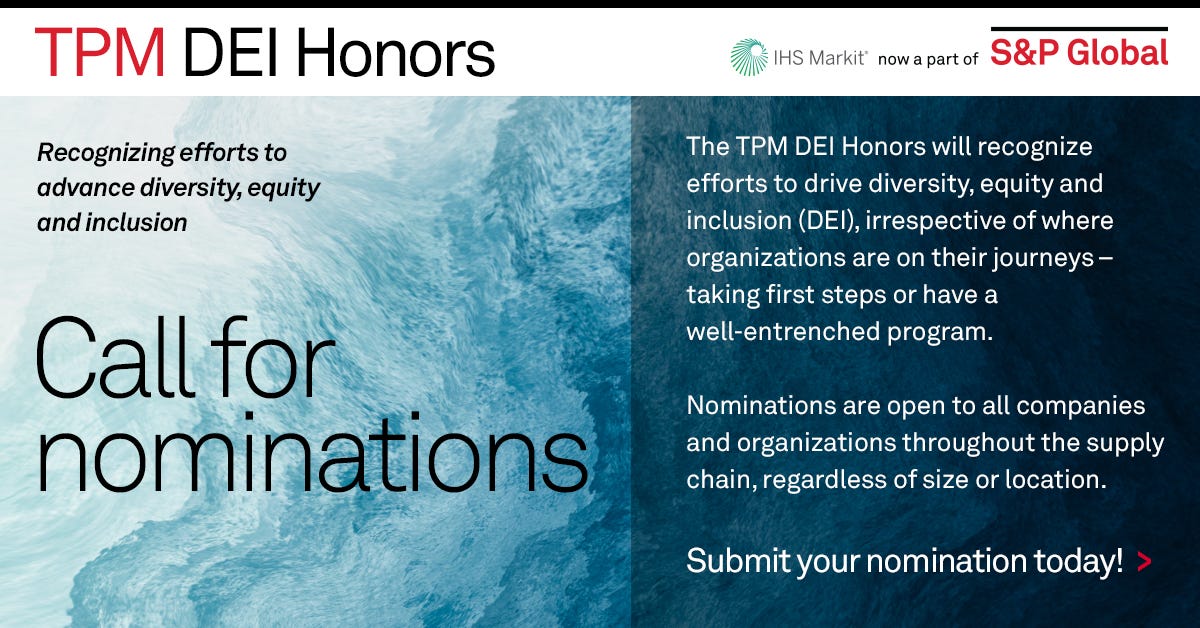How Your Email Inbox Explains LogTech Software Integrations
Welcome to the 103rd edition of The LogTech Letter. TLL is a weekly look at the impact technology is having on the world of global and domestic logistics. Last week, I delved into the hurdles of a product-led growth approach in logistics. This week, I attempt to relate how me giving up on inbox zero is relevant to logistics technology integrations.
As a reminder, this is the place to turn on Fridays for quick reflection on a dynamic, software category, or specific company that’s on my mind. You’ll also find a collection of links to stories, videos and podcasts from me, my colleagues at the Journal of Commerce, and other analysis I find interesting.
For those that don’t know me, I’m Eric Johnson, senior technology editor at the Journal of Commerce and JOC.com. I can be reached at eric.johnson@spglobal.com or on Twitter at @LogTechEric.
As I write this, I have 279,231 unread emails in my personal inbox and 3,780 unread emails in my work inbox. This long ago stopped being a problem for me. Instead of being riddled with anxiety about getting to “inbox zero,” I have instead embraced the zen posture of being at peace with all those unopened emails. What I don’t know won’t kill me.
Whenever I think of my unread email situation, I’m reminded of a friend I met early on in my journalism career. We were working at a small local weekly newspaper that may not have actually been read by anyone. We were paid peanuts. One day, my friend, who was a copy editor at the time, had an epiphany: if I proofread every single word in the newspaper, I get paid this much; if I proofread absolutely nothing, I get paid the exact same amount. And so, he proofread nothing…and no one seemed to notice.
I feel the same way with my inbox. It is what it is. It’s not a signal of a moral failing, or a lack of professionalism, or me failing to attend to details. There are just too many emails and not enough time, and unread emails are just random numbers, not anything more or less.
Now what in the world does this have to do with logistics technology? Great question. In a recent discussion with a founder, we discussed the inherent complications in integrating acquisitions. It’s not that integrations aren’t possible. It’s just that, in many cases, the integrations don’t seem to be prioritized.
I’m left to believe that acquisitive companies just don’t see value in tightly integrating acquired products in the way that the market might expect them to. It’s understandable, in a way. It’s hard to capture the market’s attention - integrations, while vital, aren’t the sexiest part of the software business. Someone should write a newsletter on that topic…
In reality, many acquired products get added to, not integrated with, a broader product suite, something I wrote about back in December 2020. Users dream of a seamless experience across all products, data flowing like water into each screen, until they reach some sort of interoperable workflow nirvana. But actually, the products remain distinct, sometimes even with unique logins, the only unifying characteristic being the logo banner on the top of the page.
But let’s be real about this. Just as my friend the copy editor realized his paycheck was unaffected by whether he actually read a single word or not, large software providers that have grown by acquisition often realize that their customer bases are reliant on them whether they integrate new products or not. The stickiness may come from one or two core products, and everything new is about cross-selling potential, not seamless additions to the existing workflow.
And here is where my overflowing email inbox is relevant. I gave up on reading every email years ago because the time and intellectual energy to do so didn’t translate to clear benefit to me. And large enterprise logistics software providers have likely come to the same conclusion. Adding customers and regions and talent and new products are the immediate benefits of acquisitions. Integrating products takes time and resources, and there’s little guarantee that time and effort will turn into anything more than incremental benefit that might not be equivalent to the time spent integrating. In fact, the benefits might not even offset the costs to integrate.
So these software companies have essentially decided to stop reading all their emails and focus on the ones that are important. Not every email is vital and neither is every product integration.
Help Us Recognize DEI Leaders at TPM23
The Diversity, Equity, and Inclusion honors will recognize organizations within transport and logistics that are working to support their people and advance their competitiveness through diversity, equity, and inclusion. Research shows a direct correlation between implementation of DEI within an organization and improved business performance. However, we also know that DEI is a journey, and thus this honor at TPM will recognize and celebrate all efforts, whether they are first steps or a well-entrenched program. Nominations are open to any company or organization throughout the transport and logistics supply chain, including ocean carriers, ports and terminals, shippers, trucking companies, railroads, logistics providers, and more − regardless of company size or location. To submit your nomination, visit https://www.judgify.me/TPM23DEIHonors. Nominations close Nov. 25.
Neal Peart Lyrics of the Week:
Nothing can survive in a vacuum
No one can exists all alone
We pretend things
Only happen to strangers
We’ve all got problems of our own
Here’s a roundup of recent pieces on JOC.com from my colleagues and myself (note: there is a paywall):
I wrote yesterday about the highlights from a panel on LTL technology at the JOC Inland Distribution Conference last week, including what panelists Curtis Garrett, Lance Healy and Michael Bookout saw as moonshots the industry should be aiming for. For more background on this topic, I spoke to Curtis on LogTech Live in May.
Altana, which I’ve written about a number of times at JOC.com, landed a mammoth $100 million round Thursday to expand its Google Maps-like approach to building a supplier network view of the world. Relatedly, I spoke to Altana’s head of trade compliance, Amy Morgan, on the last episode of LogTech Live.
Two interesting developments in the last week on tethering insurance products to visibility. First, last week Nexxiot (most known of late for being one of the vendors to outfit Hapag-Lloyd’s global box fleet with sensors) partnered with NTT Data and SAP to connect container sensor data to insurance coverage. Then yesterday, I wrote about risk management-focused visibility provider Overhaul releasing its own insurance product related to data it captures. Watch this space.
And here are some recent discussions, reports, and analysis I found interesting:
Last week, I highlighted a new long form read on platforms in logistics from Jonah McIntire, but the link was broken. So I’m re-upping this one on scale, plus the next two pieces in the four-part series, on standards and leverage. All are well worth you’re time.
One of the more underrated newsletters in our world is the Logistics Rundown, and this week’s edition on whether we’re in a reversion or a recession is particularly good.
On a similar subject, Xeneta’s CEO Patrik Berglund opined on whether falling ocean rates signal a correction or collapse.
My S&P Global colleague James Kwan penned a great blog on using data to fuel true supply chain optimization.
If you missed this report from IAPH and the World Bank on bridging the digital gaps in ports, you can rectify that today. IAPH also announced that its next global conference would be Oct. 31-Nov. 2 2023 in Abu Dhabi - that’s an event we at S&P help produce.
Speaking of ports, make sure you catch this free S&P Global webcast on understanding global port performance metrics, with Alan Murphy of Sea-Intelligence and my colleagues Greg Knowler and Turloch Mooney.
Nice blog from Transfix on the future of freight pricing activity.
Some upcoming events I’ll be involved in:
On today’s episode of LogTech Live at 10 am EST, I’ll be joined by Samantha Jones, VP of revenue at Rocket Shipping, to discuss her thoughts on our JOC Inland Distribution conference (where she spoke), why shippers need to be better at data, and how she raised her profile on LinkedIn. Subscribe here to get show details or follow the episode on my Twitter feed. This post from Samantha is a great primer ahead of our discussion.
Really delighted to join Rob Garrison on his Let’s Talk Supply Chain show First Things First noon ET Oct. 11. Make sure you’re subscribed to his show here for updates and episodes.
Talking with Shippeo’s Chris Mazza during a webinar about demystifying ocean freight visibility 2 pm ET Oct. 12. Register here.
I’m moderating an hourlong JOC webcast Oct. 27 on how technology can be a differentiator for 3PLs. Register here for the free event. Details on the panel to come soon!
Disclaimer: This newsletter is in no way affiliated with The Journal of Commerce or S&P Global, and any opinions are mine only.






Eric, great post. But I think it side steps the most significant issue that faces supply chain and logistics providers, especially at BCOs (but similarly within LSPs). The biggest challenge with any integration is the dis-similarity between systems. Each system has a design/philosophy that is unique. When you try and integrate two systems, you need to overcome the fact while each system is trying to represent related data similarly, it isn't the same. And as a result, this data needs to be somehow normalized and remediated.
One such dimension that is most often ignored or forgotten about is that of time. Just about everything in the supply chain is temporal, and while one might think that an ETA in one system is an ETA in another (as an example), ETAs change in time and so they are not necessarily the same. This is but a simple example, and it applies across all data elements that are looking to be "integrated" across systems.
Most practitioners aren't sensitive to these nuances, and as they go down the integration path they are stymied by how difficult things are. Well...the difficulty is in the lack of understand of these nuances. And so, integrations ultimately fail, or at least fail to deliver sufficient value to continue.
The solution that most companies need is a supply chain backbone that deals with this problem holistically...but they instead choose their ERP as the backbone which is not appropriate. It is good news for Oracle and SAP, but bad news for the BCOs as they don't achieve the value they are looking for.